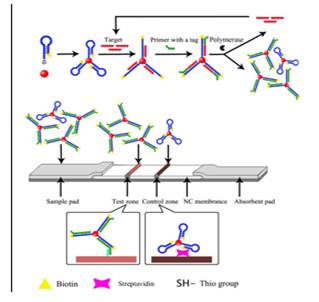A New Biosensor for Nucleic Acid Detection
The detection of nucleic acid is of central importance for the diagnosis and treatment of genetic diseases, the detection of infectious agents,biowarfare agents, and drug discovery.
Dr. ZENG Lingwen’s group at GIBH has developed a new biosensor for visual detection of nucleic acid with a detection limit of 0.01 fM, which is comparable or higher than previously reported fluorescence and colorimetric approaches. This new biosensor provides a rapid, low cost, and semi-quantitative tool for the detection of nucleic acid samples. It also provides an alternative SNP detection method for genetic diseases, personalized medicine, cancer related gene mutations, and drug resistant mutations of infectious agents. It shows great promise for in-?eld and point-of-care diagnosis of genetic diseases as well as detection of infectious agents or warning against biowarfare agents.
This technique has been published in the international prestigious academic journal “Chemical Communications”, Chem. Commun., 2012, 48, 236-238. ” http://pubs.rsc.org/en/content/articlehtml/2012/cc/c1cc15878c

As is shown in the above figure, the biosensor was composed of three parts: a sample pad, a strip of nitrocellulose membrane, and an absorbent pad. A 5’-thiol-modified, 3’-biotin-modifed 41-mer DNA hairpin probe containing the target DNA binding site was coated AuNPs. Another DNA probe was used as strand displacement primer with a sequence tag at the 5’end. A third target DNA probe was used for recognition and hybridization with the hairpin probe, triggering an ISDPR to generate large numbers of sequence tagged duplex DNA complexes. The resulting sequence tagged-duplex DNA complexes were then captured by an anti-tag DNA sequence fixed on the test zone of the nitrocellulose membrane. The red band at the control zone indicates that the biosensor works properly, and the red band at the test zone indicates the presence of target nucleic acid.
Attachment Download:
-
Contact
-
Reference
-
Related Article